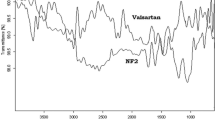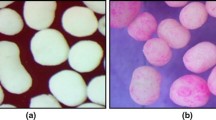Abstract
Polysaccharides, which have been explored to possess gelling properties and a wide margin of safety, were used to formulate single-unit floating matrix tablets by a direct compression technique. This work has the aim to allow continuous slow release of famotidine above its site of absorption. The floating approach was achieved by the use of the low density polypropylene foam powder. Polysaccharides (κ-carrageenan, gellan gum, xyloglucan, and pectin) and blends of polysaccharides (κ-carrageenan and gellan gum) and cellulose ethers (hydroxypropylmethyl cellulose, hydroxypropylcellulose, sodium carboxymethyl cellulose) were tried to modulate the release characteristics. The prepared floating tablets were evaluated for their floating behavior, matrix integrity, swelling studies, in vitro drug release studies, and kinetic analysis of the release data. The differential scanning calorimetry and Fourier transform infrared spectroscopy studies revealed that changing the polymer matrix system by formulation of polymers blends resulted in formation of molecular interactions which may have implications on drug release characteristics. This was obvious from the retardation in drug release and change in its mechanistics.








Similar content being viewed by others
References
A. Bartkowiak, and D. Hunkeler. Carrageenan–oligochitosan microcapsules: optimization of the formation process. Colloids Surf. B Biointerfaces. 21:285–298 (2001).
K. M. Picker. Matrix tablets of carrageenans. ΙΙ. Release behavior and effect of added cations. Drug Dev. Ind. Pharm. 25:339–346 (1999).
S. Miyazaki, N. Kawasaki, W. Kubo, K. Endo, and D. Attwood. Comparison of in situ gelling formulations for the oral delivery of cimetidine. Int. J. Pharm. 220:161–168 (2001).
K. Nishinari, K. Yamatoya, and M. Shirakawa. Xyloglucan. In G. O. Phillips, and P. A. Williams (eds.), Handbook of Hydrocolloids, CRC, Boca Raton, 2000, pp. 247–267.
C. Rolin. Pectin. In R. L. Whistler, and J. N. Bemiller (eds.), Industrial Gums: Polysaccharides and their Derivatives, Academic, New York, NY, 1993, pp. 257–293.
J. Nerurkar, H. W. Jun, J. C. Price, and M. O. Park. Controlled-release matrix tablets of ibuprofen using cellulose ethers and carrageenans: effect of formulation factors on dissolution rates. Eur. J. Pharm. Biopharm. 61:56–68 (2005).
S. Sungthongjeen, T. Pitaksuteepong, A. Somsiri, and P. Sriamornsak. Studies on pectins as potential hydrogel matrices for controlled-release drug delivery. Drug Dev. Ind. Pharm. 25:1271–1276 (1999).
Y. D. Sanzgiri, S. Maschi, V. Crescenzi, L. Callegaro, E. M. Topp, and V. J. Stella. Gellan-based systems for ophthalmic sustained delivery of methylprednisolone. J. Control. Release. 26:195–201 (1993).
S. A. Agnihorti, S. S. Jawalkar, and T. M. Aminabhavi. Controlled release of cephalexin through gellan gum beads: effect of formulation parameters on entrapment efficiency, size, and drug release. Eur. J. Pharm. Biopharm. 63:249–261 (2006).
P. S. Rajinikanth, J. Balasubramaniam, and B. Mistral. Development and evaluation of a novel floating in situ gelling system of amoxicillin for eradication of Helicobacter pylori. Int. J. Pharm. 335:114–122 (2006).
S. Miyazaki, F. Suisha, N. Kawasaki, M. Shirakawa, K. Yamatoya, and D. Attwood. Thermally reversible xyloglucan gels as vehicles for rectal drug delivery. J. Control Release. 56:75–83 (1998).
F. Suisha, N. Kawasaki, S. Miyazaki, M. Shirakawa, K. Yamatoya, M. Sasaki, and D. Attwood. Xyloglucan gels as sustained release vehicles for the intraperitoneal administration of mitomycin C. Int. J. Pharm. 172:27–32 (1998).
N. Kawasaki, R. Ohkura, S. Miyazaki, Y. Uno, S. Sugimoto, and D. Attwood. Thermally reversible xyloglucan gels as vehicles for oral drug delivery. Int J Pharm. 181:227–234 (1999).
C. Dollery. In: Therapeutic Drugs, volume Ι, 2nd edition, Churchill Livingstone, Edinburgh London New York Philadelphia San Francisco Sydney Toranto; 1999.
B. Mehta, M. M. Doshi, M. D. Joshi. Floating osmotic device for controlled release drug delivery. US Patent. 2003;20030064101.
Y. F. Hui, J. Kolars, Z. Hu, and D. Fleisher. Intestinal clearance of H2-antagonists. Biochem. Pharmacol. 48:229 (1994).
J. T. Fell, L. Whitehead, and J. H. Collet. Prolonged gastric retention using floating dosage forms. Pharm. Technol. 24(3):82–87 (2000).
L. Illum, and P. He. Gastroretentive controlled release microspheres for improved drug delivery. US Patent 2001;6,207,197.
P. Dettmar, P. A. Dickson, F. C. Hampson, I. G. Jollife, and W. Peers. Mucoadhesive granules of carbomer suitable for oral administration of drugs. US Patent 2001;6,306,789.
M. Jaimini, A. C. Rana, and Y. S. Tanwar. Formulation and evaluation of famotidine floating tablets. Current Drug Delivery. 4(1):51–55 (2007).
A. Streubel, J. Siepmann, and R. Bodmeier. Floating matrix tablets based on low density foam powder: effects of formulation and processing parameters on drug release. Eur. J. Pharm. Sci. 18:37–45 (2003).
P. L. Bardonnet, V. Faivre, W. J. Pugh, J. C. Piffaretti, and F. Falson. Gastroretentive dosage forms: Overview and special case of Helicobacter pylori. J. Control Release. 111:1–18 (2006).
M. Rosa, H. Zia, and T. Rhodes. Dosing and testing in-vitro of a bioadhesive and floating drug delivery system for oral application. Int. J. Pharm. 105:65–70 (1994).
P. L. Ritger, and N. A. Peppas. A simple equation for description of solute release ΙΙ. Fickian and anomalous release from swellable devices. J. Control Release. 5:37–42 (1987).
L. Vachoud, N. Zydowicz, and A. Domard. Physicochemical behavior of chitin gels. Carbohydr. Res. 326:295–304 (2000).
B. Saša, P. Odon, S. Stane, and K. Julijana. Analysis of surface properties of cellulose ethers and drug release from their matrix tablets. Eur. J. Pharm. Sci. 27:375–383 (2006).
D. A. Alderman. A review of cellulose ethers in hydrophilic matrices for oral controlled-release dosage forms. Int. J. Pharm. 5(3):1–9 (1984).
J. Timmermans, and A. J. Moes. The cutoff size for gastric emptying of dosage forms. J. Pharm. Sci. 828:854 (1993).
G. Chawla, P. Gupta, V. Koradia, and A. K. Bansal. Gastroretention: a means to address regional variability in intestinal drug absorption. Pharm. Tech. 27:50–68 (2003).
P. Sher, G. Ingavle, S. Ponrathnam, and A. P. Pawar. Low density porous carrier: Drug adsorption and release study by response surface methodology using different solvents. Int. J. Pharm. 331:72–83 (2007).
T. W. Wong, H. Y. Lee, L. W. Chan, and P. W. S. Heng. Drug release properties of pectinate microspheres prepared by emulsification method. Int J Pharm. 242:233–237 (2002).
Y. Pranoto, C. M. Lee, and H. J. Park. Characterizations of fish gelatin films added with gellan and κ-carrageenan. LWT. 40:766–774 (2007).
A. S. Hussain, R. D. Johnson, P. Shivanand, and M. A. Zoglio. Effects of blending a nonionic and an anionic cellulose ether polymer on drug release from hydrophilic matrix capsules. Drug Dev. Ind. Pharm. 20(17):2645–2657 (1994).
M. G. Sankalia, R. C. Mashru, J. M. Sankalia, and V. B. Sutariya. Stability improvement of alpha-amylase entrapped in kappa-carrageenan beads: Physicochemical characterization and optimization using composite index. Int. J. Pharm. 312:1–14 (2006).
A. R. Menjoge, and M. G. Kulkarni. Mechanistic investigations of phase behavior in Eudragit® E blends. Int. J. Pharm. 343:106–121 (2007).
B. N. Singh, and K. H. Kim. Characterization and relevance of physicochemical interactions among components of a novel multiparticulate formulation for colonic delivery. Int. J. Pharm. 341:143–151 (2007).
K. S. Bhise, R. S. Dhumal, B. Chauhan, A. Paradkar, and S. S. Kadam. Effect of oppositely charged polymer and dissolution medium on swelling, erosion, and drug release from chitosan matrices. AAPS PharmSciTech. 2007 8(2):article 44(E1–E9).
B. Hegedus, P. Bod, K. Harsanyi, I. Peter, A. Kalman, and L. Parkanyi. Comparison of the polymorphic modifications of famotidine. J. Pharma. Biomed. Anal. 7:563 (1989).
Author information
Authors and Affiliations
Corresponding author
Additional information
Guest Editors: Stephen A. Howard and Jian-Xin Li
Rights and permissions
About this article
Cite this article
Elmowafy, E.M., Awad, G.A.S., Mansour, S. et al. Release Mechanisms Behind Polysaccharides-Based Famotidine Controlled Release Matrix Tablets. AAPS PharmSciTech 9, 1230–1239 (2008). https://doi.org/10.1208/s12249-008-9155-4
Received:
Accepted:
Published:
Issue Date:
DOI: https://doi.org/10.1208/s12249-008-9155-4




